|
AND YOUR BIRD CAN SING
The Great WoS Handheld Head-To-Head
Alert WoS viewers will know that 2007 so far - like most of 2006 before it - has been all about portable gaming. I can't recall playing a single Xbox 360 or PS2 game this year (the only reason the dust got blown off the 360 at all was to try a couple of disappointing XBLA releases), and at a recent party full of gamers and games writers and an almost full catalogue of Wii games, I couldn't even be bothered picking up the remote. At the same time, my PSP and DS Lite both need charging almost every day, and when I'm out and about, whether by car or on foot, my GBA SP and game-stuffed mobile phone are always within arm's reach.
But the question I'm asked most often when I've stupidly turned up at a casino an hour early for a poker game and am damaging the house profits by quaffing free pints of Coke and sitting in the corner with a console instead of throwing away my cash on the roulette tables is this one: "Hey, weirdo - which is best, the DS or the PSP?"
And y'know, gaming mags and websites always duck that simple question, too scared of upsetting one side or the other and haemorrhaging readers and/or ad revenue (or just assuming that all their readers have the spare £300 needed to buy both machines - and that's before you get any games). But WoS, which is quite bored today, is made of more fearless stuff, and by the time we get to the end of this comprehensive, methodical and remorselessly scientific feature you can knock us over with a dead pig if we haven't come up with an authoritative, definitive, mathematically-bulletproof answer to the burning question everyone probably already made their own minds up about nine months ago. Let's get with it, kittens.
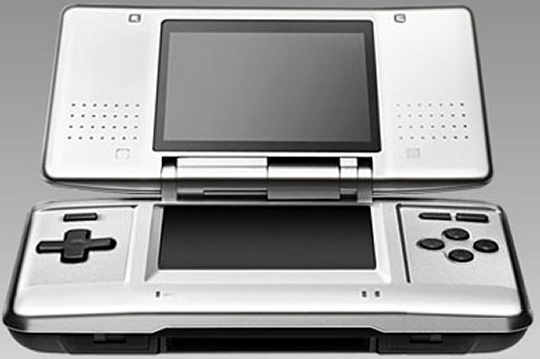
This console does not appear in the following feature.
CATEGORY 1: HARDWARE DESIGN
All the way through this piece, we'll obviously be talking about the DS Lite. The original DS was a monstrosity - fat and lumpy and grey and looking like some kind of 1970s ashtray or original-series Star Trek communicator. The Lite, however, is a masterpiece of design. Borrowing shamelessly from the iPod, it has clean, simple lines surrounding a compact and efficient unit where every square centimetre of space serves a purpose. Four face buttons and two shoulder buttons provide for every sane control requirement (seriously, if you've written a game that needs more than six main fire buttons, you're doing it wrong. Go back and start again, Dr Nerdstrom), and everything's laid out ergonomically with enough grip-space for even fairly chunky hands to get a comfortable hold that won't result in crippling RSI 20 minutes into New Super Mario Brothers. Just about the only thing on the Lite it's possible to criticise from a design perspective is the clear protective "shell" which, on the black version, is a magnet for fingerprints and smudges and dust particles and makes the machine look very tatty within seconds of anyone picking it up (although only when it's not in use, since the inside surfaces are matt rather than shiny). It's more or less the only flaw in a near-perfect design concept and execution, though. Second time lucky again, eh Nintendo?
The PSP, on the other hand, is a mess. Clearly designed primarily for aesthetic appeal rather than functionality, there's something wrong with almost every aspect of it. The analogue nub is hopeless, with a massive deadzone and then wild oversensitivity at the edges. It's placed awkwardly low down at one corner, giving the console an unbalanced, hand-contorting orientation if you're using the nub and the face buttons at the same time. The Square button has been placed too close to the screen, apparently forcing it to sit on top of some piece of internal circuitry so that there's a noticeable obstruction if you try to press it by sliding across from the middle. There are way too many buttons on the thing full stop - an incredible thirteen, not counting the d-pad or analogue nub or the power switch and such - and the Start and Select buttons are so small, recessed and close together than you actually have to look down to see which one you're pressing if you need them for anything in a game.
The PSP also has a thin, rough metal ridge running along its bottom edge, which digs into any fingers you use to support its weight. (It's about twice as heavy as the DS and 2" wider, which makes it uncomfortable to hold for any period of time if you don't support it underneath somehow. In fact, it's uncomfortable to hold in almost any position and no matter which of its controls you're using.) Everything about the machine has been designed to accommodate the vast screen, and it suffers badly for it. It also has the same aesthetic smudging problem as the black DS Lite - only more so, because you get the unattractive smudges all over the screen and control surfaces as well as the outer casing. All in all, a bit of a catastrophe.
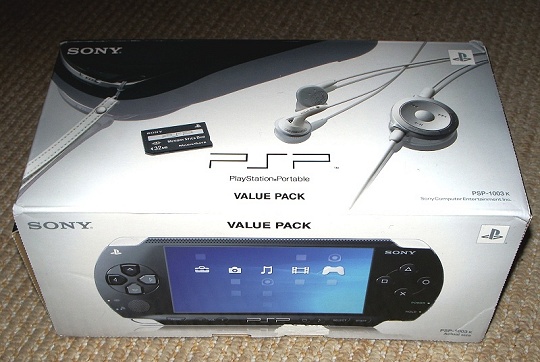
My very own PSP, indirectly bought by the viewers of WoS. I love you, viewers of WoS.
CATEGORY 2: BUILD QUALITY
This is another category where it's hard to find fault with the DS. It feels very solid, and everything does its job as it's supposed to. While the original DS had rather poor, washed-out screens, the new ones in the Lite are wonderfully bright and clear, and the touchscreen detection is sensitive and accurate, to the point where you can use the stylus to type at a pretty respectable rate on the homebrew PDA program DSOrganise without even looking at the screen. If you had to identify a weakest link, the tiny d-pad would probably be it, occasionally being a fraction reluctant to pick up diagonals, but it works perfectly 99% of the time. Nintendo will also replace the screen if it has so much as one dead pixel. Smashing.
The PSP manual, on the other hand, practically promises you dead pixels. Mine had six or seven out of the box, of varying prominence and position (only two of them really leap out at you), and Sony refuse to replace a unit on the grounds of dead pixels unless they substantially interfere with the gameplay experience (or words to that effect). This is utterly contemptible in a machine costing £180 (a PSP without a memory stick is functionally all but useless, so forget the £150 "Base Pack"), but incredibly it's not the worst aspect of the PSP's build quality. That dishonour goes to the d-pad, which is nothing short of a complete disgrace. It's set so low into the machine's casing that diagonal movements are all but impossible - if you're playing a game where you ever need to move in anything more than the four compass directions, you better hope it lets you use the analogue nub, because otherwise you're boned. It beggars belief that the machine was released with its primary controller in this condition.
The PSP's display is its most commonly-praised feature, and it's certainly rather lovely. The image is pin-sharp and colours come absolutely searing out of the screen, but even here all isn't quite right. There's some terrible pixel-bleeding when things scroll quickly - check out any game with small scrolling text, or take a look at Rally-X on the loading screen of Ridge Racer and you'll really notice how badly the image can leave ghost trails, like a cheapo TFT monitor with a long response time. There are few games where it's very noticeable and none where it affects gameplay, but it's still a little bit tacky for what you're paying. And finally, the PSP's many battery compartments, doors, flaps etc feel very wobbly and fragile. None of mine have ever snapped off, but they feel like they could at any time. Which is worrying.
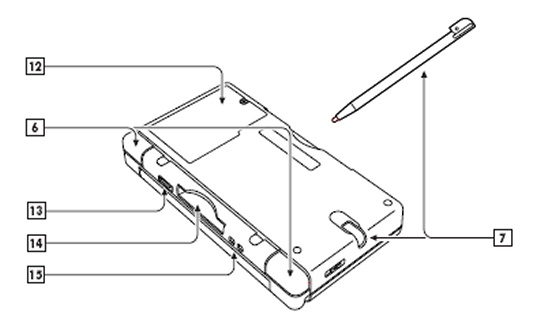
This is the WRONG way to use the stylus. The WRONG way.
CATEGORY 3: NATIVE SOFTWARE
The PSP has something of a bad reputation in this area, and it's rather undeserved. There certainly is a lot of lazy PS2 shovelware out there, but the machine also plays host to a very wide range of original, high-quality games. From sports sims to party games, from racers to puzzlers, from sandbox gangster epics to pinball, shooters and sizeable retro packs, the PSP has most genres well covered. What's more, you'll find most of them easily in the average High Street retailer, if you're daft enough to buy your videogames from High Street retailers.
The DS, on the other hand, can't compete with the PSP's range when it comes to traditional game genres. It's noticeably short of halfway-decent racing games (more or less the only really good one is a direct port of the eight-year-old Ridge Racer 64), has nothing to compete with the PSP's two GTA spinoffs, isn't blessed with much in the way of FPSes and has no decent retro compilations. (The only one with more than one game is the semi-remakes release Atari Retro Classics, most of which is absolutely stupefyingly awful). And what good stuff the DS does have, you'll struggle to find on a shop shelf - anything that isn't either a Nintendo flagship franchise or a horrible Disney movie licence for kids will more than likely have to be bought online, because those are pretty much all your average games shop sells.
On the upside, the DS has a couple of big compensatory advantages. The touchscreen makes whole new types of game available, and most of the console's best titles make use of the machine's unique features. The likes of Nintendogs or Phoenix Wright or Wario Ware Touched or Trauma Centre: Under The Knife simply wouldn't work a hundredth as well on the PSP, and even rather tired old games like ActionLoop and Zoo Keeper get a massive new lease of life when adapted to utilise the stylus - puzzle games, in fact, do especially well with this type of control, and the DS leaves the PSP standing in that particular field.
The DS's other big strength, of course, is the aforementioned flagship Nintendo franchises. As wide as the PSP's range is, nothing in it reaches the stellar individual heights of Advance Wars or New Mario or Ouendan or Castlevania: Dawn Of Sorrow. These are genre-defining titles, and for the serious discerning gamer are, taken singly, superior to anything in the PSP's catalogue. In the end it boils down to personal taste - if you love racing games above all else you'd be daft to buy a DS, but if platformers are your favourite thing then a PSP would be a waste of money. Overall, though, the PSP probably just shades it for breadth and availability.
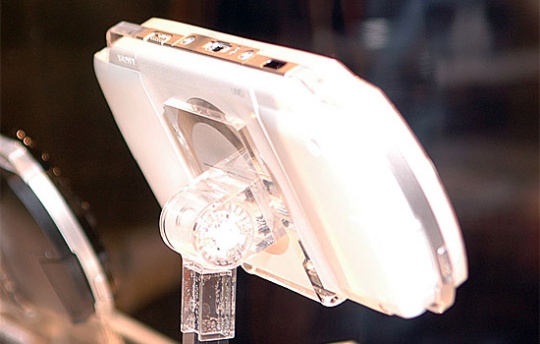
This PSP is white. Move along.
CATEGORY 4: MULTI-GAME CAPABILITY
As we find ourselves well into the iPod era, it's long struck this reporter as odd that you can't buy a games machine off the shelf with the ability to store and play multiple games. If you could download DS or PSP games straight onto hard drive, flash drive or memory card like you can download an iTunes track, gamers would get convenience and choice, and publishers could sell without middlemen or physical manufacturing/stock inventory costs, enabling them to make greater profits per unit and also to drive sales up by cutting prices. Everybody would win. (And it's hard to see how it could make piracy worse, given that every new game is already BitTorrented on the day of release anyway.)
But I don't run the world, so gamers who don't want to carry pockets full of easily-loseable little carts and alarmingly fragile UMD discs around with them have to call on the assistance of third parties. Man, everyone in the videogames industry except me is an idiot.
DS owners have things slightly easier here. There's already a vast range of multiple-game solutions, comprising both flash-memory and memory-card units, plugging into both the GBA slot and the standard DS cart slot. For under £50 you can buy a card-and-adapter combo capable of holding upwards of 70 average-sized DS games downloaded off the internet, which simply plugs straight in like an ordinary cart and doesn't require you to modify your console in any way. It has all the functionality of normal carts, and is actually superior in several ways - saved games can be backed up to your PC or Mac for extra security, and you can also run homebrew applications (of which we'll hear more in Category 5.) Expanding your storage space later on is as easy as buying another £10 memory card.
Multi-gaming is a bit trickier on the PSP, but not much. The one big obstacle is that you have to replace the console's built-in firmware with a hacked, customised version, which carries with it the (very slight) risk of "bricking" your machine and rendering it useless. Finding clear, well-written instructions to perform this procedure isn't as easy as it might be, but once you've found them the actual process is quick, simple and painless. At that point you can pick up a 4GB memory stick for around the same as the cost of the DS card/adapter combo (at that price it'll probably be a fake, but most fakes work perfectly well - if you want a genuine one, budget closer to £100), which will hold from 6 to 30 PSP games in CSO format. Once you've got the custom firmware installed, adding games to it is as easy as with the DS - just drag and drop to the memory card, which your PC or Mac will treat as a hard drive. On the PSP there's the added bonus of being able (via a homebrew application) to dump your own UMD games to an ISO file, rather than having to download copies of them off the net.
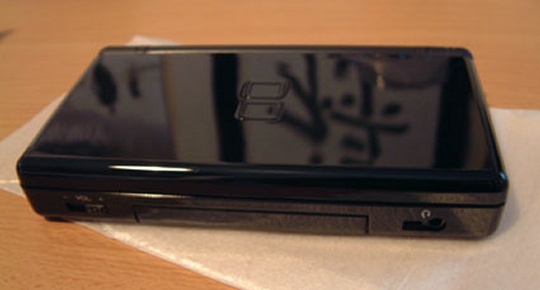
The black DS Lite will look this beautiful forever. As long as you never, ever touch it.
CATEGORY 5: NON-NATIVE SOFTWARE But this, cherished viewers, is where things get really interesting. As we've seen above, there's little to choose between the two formats in terms of software specifically written for them. But it's what else they can run that really makes these machines worth owning.
The big secondary selling-point of the DS, of course, is its ability to run original Game Boy Advance games. Simply plug your GBA cart (including multi-game flashcarts) into Slot 2 on the DS and it'll run as if it was in a real GBA. The drawback is that with the DS Lite (as opposed to the old DS Chunky) the cart will stick out untidily about half-an-inch from the bottom of the machine, which is very inelegant but ultimately not much of a price to pay for opening up the vast library of brilliant GBA titles. However, if you've bought a flashcart (see Category 4), your DS can do more. Depending on which one you buy, you can run a variety of emulators, most excitingly (to this reporter) of the ZX Spectrum. The Speccy ran at exactly the same screen resolution as the DS, so games fit the screen perfectly, and the bright primary colours look absolutely gorgeous when illuminated by the powerful DS backlight. The touchscreen serves as a Spectrum keyboard, making the emulator vastly easier to use than those for previous handhelds, and the whole adventure is a sheer heartwarming joy all round (if you're old enough to care about the Speccy, anyway.).
It's also possible, depending on your choice of flashcart, to run GBA-based emulators of consoles like the NES, Sega Master System, and the original mono Game Boy - with lots of added functionality like save states, customisable controls and selectable palettes - and free homebrew games, although only a few of them are currently really worth the effort.
The PSP, while less well-served with application software (and similarly short on worthwhile homebrew games), is more than a match for the DS in the retrogaming field. Indeed, as long as you've installed the custom firmware, it's little short of spectacular. The star of the show is backwards compatibility with Playstation 1 games - you can take your entire shelf of PS1 titles and easily and quickly convert them to ISO files, most of which will run absolutely beautifully on the PSP. To play arcade-perfect Raiden, or Tempest X3, on a portable games machine is an experience that'll bring a tear of happiness to the eye of the weariest cynic.
But it doesn't end there. The customised PSP can also run Neo Geo emulators (Metal Slug!) and CPS1 and CPS2 arcade emulators (Final Fight! Giga Wing!), and even out-Nintendos Nintendo with the advent of Rin, an emu which - unlike the DS - plays Game Boy and Game Boy Color games at full speed, with saving, on the big screen, where the likes of Super Mario Land and Revenge Of The Gator look thoroughly glorious. There are also fully-functioning emulators for more primitive systems like the Atari VCS, SAM Coupé (a great version of Manic Miner) and ZX81 (Curse Of The Aztec Tomb 2000, obv), and work-in-progress ones for the SNES and Mega Drive. In fact, the PSP is so good at emulating old systems that you'll be hard-pushed to find space on your memory stick for any PSP games.

Using your DS like this will make people point at you and say cruel things.
CATEGORY 6: OTHER STUFF - both consoles offer wireless multiplayer play. It's probably quite good. NO SCORE
- contrary to what you might have read, battery life on a DS with a flashcart in it and a modified PSP are almost exactly the same, at roughly five hours from a full charge. (Although running PS1 games on a PSP sets its clock speed to 333MHz instead of 222MHz, reducing battery life to something closer to three hours.) NO SCORE
- the maximum volume on the DS is a bit weedy, whereas the PSP can be heard over the sound of a helicopter gunship exploding 20 feet away. PSP SCORE: +1
- at the higher brightness settings, both consoles can be used quite effectively as a torch. No, seriously. The intriguingly politically-satirical PSP game Work Time Fun actually offers a torch facility as an unlockable bonus feature. NO SCORE
- you can use the PSP straight out of the box to display photos, watch movies and play music. With the DS you need to buy extra hardware. PSP SCORE: +1
- the DS can (just about) actually fit in your pocket, even in summertime. The PSP isn't so much a "handheld" console in the sense of the Game Boy etc, as a "portable" console, ie a small one that you can take from one building to another in a bag. (The dimensions of the two machines aren't all that different, but because it lacks the clamshell design, the PSP needs to travel in its protective pouch, which makes it too bulky for all but MC Hammer's pockets.) While the DS feels solid enough to play anywhere, you'd be terrified to get the PSP out on the beach, because a single grain of sand could damage it irreparably. DS SCORE: +1
- you can adjust the brightness of the PSP screen at the touch of a button. The DS only lets you alter the brightness from the boot menu - if lighting conditions change, you have to switch the game off, change the brightness and load it up again. PSP SCORE: +1
- if I ever meet the person who came up with the idea of blowing into the DS' microphone, I will stab them repeatedly in the lungs, sneering ironically all the while. DS SCORE: -1
- Sony are engaged in constant efforts to remove (via compulsory firmware "upgrades" needed to run new games) most of the functionality we've discussed in this feature that makes the PSP worth owning. Maybe one day they'll succeed. Once they've got your money, Nintendo leave you the hell alone. PSP SCORE: -1
- the DS costs barely over half what a fully-functional PSP does. DS SCORE: +1
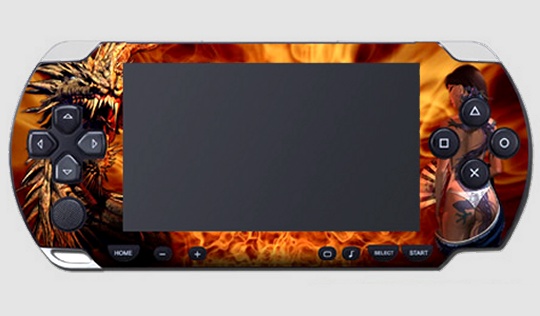
If you do this, you are a moron.
And there we have it. To be honest, I'm slightly surprised the margin is as big as six points, since my DS and PSP get more or less equal play time (at least since the advent of PS1 and GB emulation on the Sony machine). The PSP never manages to recover from its dreadful form-over-function design and shoddy, penny-pinching build quality - although there's scarcely a hair's breadth between the two machines in terms of content, the DS is just so much lovelier to use. If you could play Raiden or Gradius without having to contort your left hand to use the stupid analogue nub and shred both of your little fingers on the razor-ridge, that'd probably have been worth at least two or three more points on its own - whoever tested the d-pad and pronounced it satisfactory really, really needs to be punched hard in the face every day from now until Christmas. (There are apparently attachments you can buy to improve the d-pad, but when you've paid £180 for a piece of tech, you shouldn't have to fucking dismantle and rebuild the thing, voiding your warranty, in order to make it perform the most basic operations properly. Installing the custom firmware is scary enough, thanks.)
So if you've only got enough money for one handheld games machine, WoS officially recommends the DS Lite. If you can get a PSP for nothing (like I was fortunate enough to), be very happy - you'll have a lot of fun with it. But in more than one sense, Sony need to take a leaf out of Nintendo's book, go back to the drawing board and get it right the second time.
|

